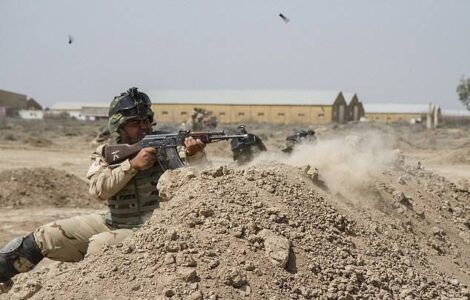
At least 7000 Islamic State terrorists to stage new attacks after taking advantage of pandemic to reorganise in Iraq
At least 7,000 ISIS fighters have taken advantage of the coronavirus pandemic to reorganise themselves in Iraq, according to a Kurdish general.
Sirwan Barzani, a Peshmerga commander stationed in Arbil, said the lack of anti-ISIS operations in the region had provided jihadists with an opportunity to emerge from hiding, The Times reports.
Speaking to the paper, the Kurdish general said that the group still posed a ‘big threat for all of the world’, estimating more than 7,000 ISIS fighters are still in Iraq.
Barzani explained that when the Islamic State territory was liberated, many of the fighters shaved their beards and posed as members of the public.
He said: ‘They reorganised themselves quicker because of the pandemic.’
The coronavirus pandemic was cited by Barzani as one of the reasons why ISIS has been able to regroup, because coalition forces had not been carrying out operations as regularly.
He stated that an RAF strike last month against a depot containing IEDs was the first action taken by British forces in three months.
However, a Ministry of Defence spokesperson told The Times that the pandemic had not had an impact on the frequency of coalition attacks and that any strikes were a ‘final step’ led by intelligence.
Coalition training of Iraqi and Kurdish forces had been suspended last January after a US airstrike killed Iranian general Qasem Soleimani.
The same training was paused again when the coronavirus pandemic started spreading.
Following the handover of Camp Taji in northern Baghdad to Iraqi forces, only 100 British soldiers remain, while only 2,500 American troops are still stationed in the country.
It comes after two ISIS terror cells were destroyed by RAF fighter jets using laser-guided bombs in Iraq.
A pair of RAF Typhoon FGR4s conducted simultaneous attacks using two Paveway IV guided bombs to kill the terrorists based in two caves near Bayji, a city 130 miles north of Baghdad.
A coalition surveillance aircraft had located a number of ISIS fighters on January 24 and the two fighter jets were tasked to strike them, according to a statement by the Ministry of Defence.
The pilots checked the area around the caves, which were a mile and a half apart, for any signs of civilians who could have been at risk. They then simultaneously launched two laser-guided bombs against each group.
‘All four of the bombs struck the targets accurately and the strike was assessed to have been a success in eliminating the terrorist threat’, the MoD said. They did not reveal how many casualties there were.
Coalition operations against ISIS began in 2014 when America began a bombing campaign in Iraq and Syria, and began supporting forces on the ground – largely led by the Kurds – in order to push the terror group back.
By early 2016, the US estimated that ISIS had lost 40 per cent of the 36,000 square miles of territory it once held.
The following year ISIS lost the battle for Mosul, its last stronghold in Iraq, shortly before being driven out of Aleppo in Syria.
In March 2019, the terrorist’s last redoubt – a sliver of land called Baghouz in Syria – was captured by Kurdish forces, spelling the end of the group as a territorial power.
Since then ISIS has transformed into a guerrilla fighting force similar to Al Qaeda, directly launching bomb and gun attacks in Syria and Iraq.
Last year, Masrour Barzani, prime minister of the autonomous region of Iraqi Kurdistan, warned Isis had double the number of soldiers it had when it began capturing territory in Iraq and Syria in 2014.
While ISIS has lost all of its territory and much of its leadership, last year, Barzani believed the terror group still had 20,000 fighters spread across Iraq and Syria and had been trying to recruit more.
Source: Daily Mail





